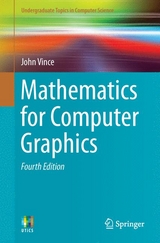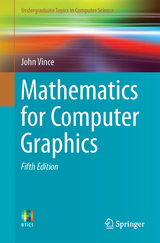Mathematics for Computer Graphics
Springer London Ltd (Verlag)
978-1-4471-6289-6 (ISBN)
- Titel erscheint in neuer Auflage
- Artikel merken
John Vince explains a wide range of mathematical techniques and problem-solving strategies associated with computer games, computer animation, virtual reality, CAD and other areas of computer graphics in this updated and expanded fourth edition.
The first four chapters revise number sets, algebra, trigonometry and coordinate systems, which are employed in the following chapters on vectors, transforms, interpolation, 3D curves and patches, analytic geometry and barycentric coordinates. Following this, the reader is introduced to the relatively new topic of geometric algebra, and the last two chapters provide an introduction to differential and integral calculus, with an emphasis on geometry.
Mathematics for Computer Graphics covers all of the key areas of the subject, including:
Number sets
Algebra
Trigonometry
Coordinate systems
Transforms
Quaternions
Interpolation
Curves and surfaces
Analytic geometry
Barycentric coordinates
Geometric algebra
Differential calculus
Integral calculus
This fourth edition contains over 120 worked examples and over 270 illustrations, which are central to the author’s descriptive writing style. Mathematics for Computer Graphics provides a sound understanding of the mathematics required for computer graphics, giving a fascinating insight into the design of computer graphics software and setting the scene for further reading of more advanced books and technical research papers.
Prof John Vince began working in computer graphics at Middlesex Polytechnic in 1968. His research activities centered on computer animation software and resulted in the PICASO and PRISM animation systems. Whilst at Middlesex, he designed the UK’s first MSc course in Computer Graphics and developed a popular program of short courses in computer animation for television designers. In 1986 he joined Rediffusion Simulation as a Research Consultant and worked on the development of real-time computer systems for commercial flight simulators. In 1992 he was appointed Chief Scientist of Thomson Training Simulation Ltd. In 1995 he was appointed Professor of Digital Media at the National Centre for Computer Animation at Bournemouth University and in 1999 he was made Head of Academic Group for Computer Animation. He was awarded a DSc by Brunel University in recognition of his work in computer graphics. He has written and edited over 40 books on computer graphics, computer animation and virtual reality, including the following Springer titles: Calculus for Computer Graphics (2013) Matrix Transforms for Computer Games and Animation (2012) Expanding the Frontiers of Visual Analytics and Visualization (2012) Quaternions for Computer Graphics (2011) Rotation Transforms for Computer Graphics (2011)
Preface.- Mathematics.- Numbers.- Algebra.- Trigonometry.- Coordinate Systems.- Vector.- Transforms.- Interpolation.- Curves and Patches.- Analytic Geometry.- Barycentric Coordinates.- Geometric Algebra.- Calculus: Derivatives.- Calculus: Integration.- Worked Examples.- Conclusion.- Index.
| Reihe/Serie | Undergraduate Topics in Computer Science |
|---|---|
| Zusatzinfo | 14 Tables, black and white; 282 Illustrations, black and white; XVII, 391 p. 282 illus. |
| Verlagsort | England |
| Sprache | englisch |
| Maße | 155 x 235 mm |
| Gewicht | 629 g |
| Themenwelt | Mathematik / Informatik ► Informatik ► Grafik / Design |
| Mathematik / Informatik ► Informatik ► Software Entwicklung | |
| Mathematik / Informatik ► Mathematik ► Algebra | |
| Mathematik / Informatik ► Mathematik ► Angewandte Mathematik | |
| Schlagworte | Computer Aided Design (CAD) • Computer Animation • Computer Games • Computergrafik • Computer Graphics • Mathematic Applications in Computer Science • Mathematik |
| ISBN-10 | 1-4471-6289-7 / 1447162897 |
| ISBN-13 | 978-1-4471-6289-6 / 9781447162896 |
| Zustand | Neuware |
| Haben Sie eine Frage zum Produkt? |
aus dem Bereich





